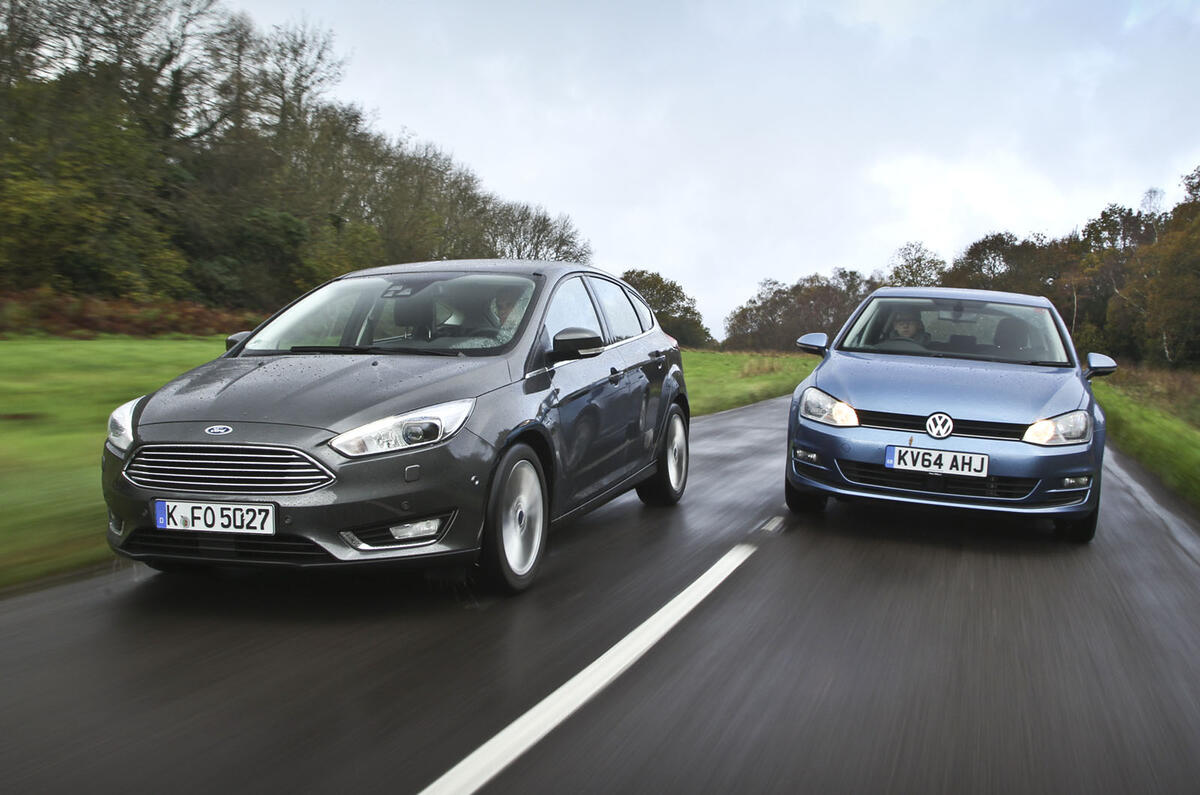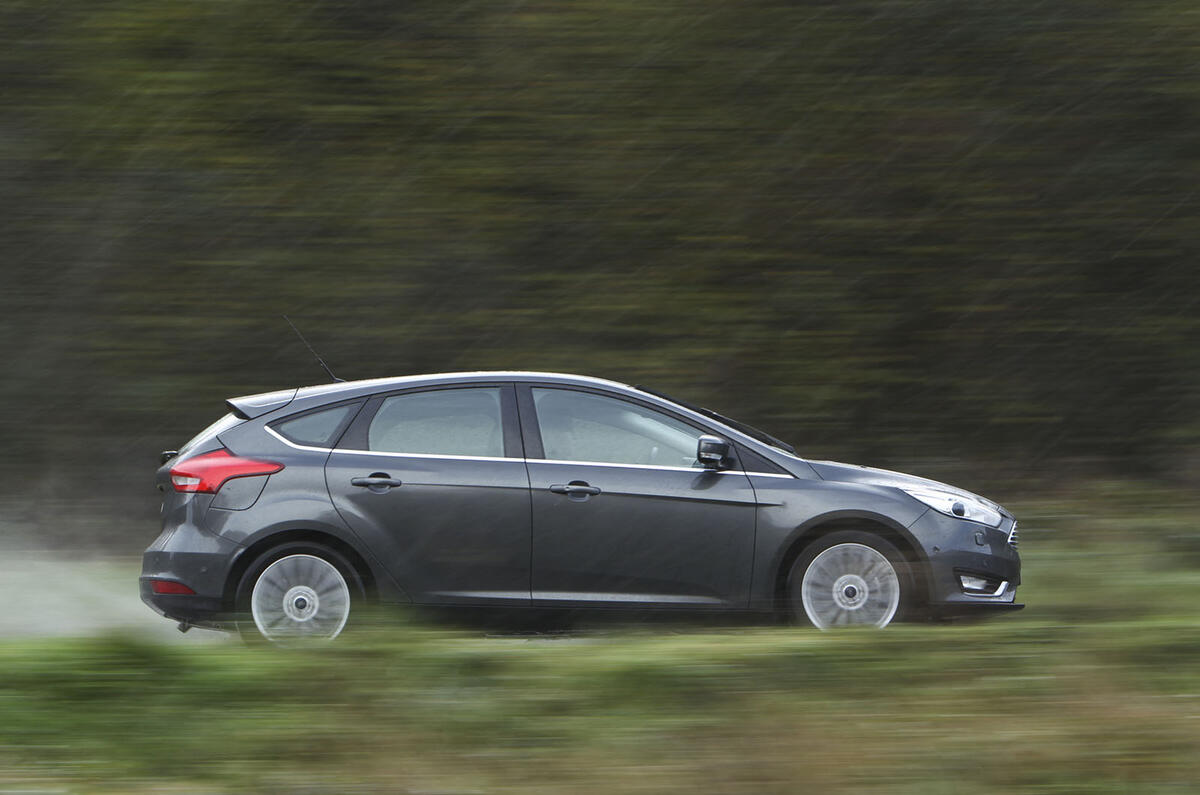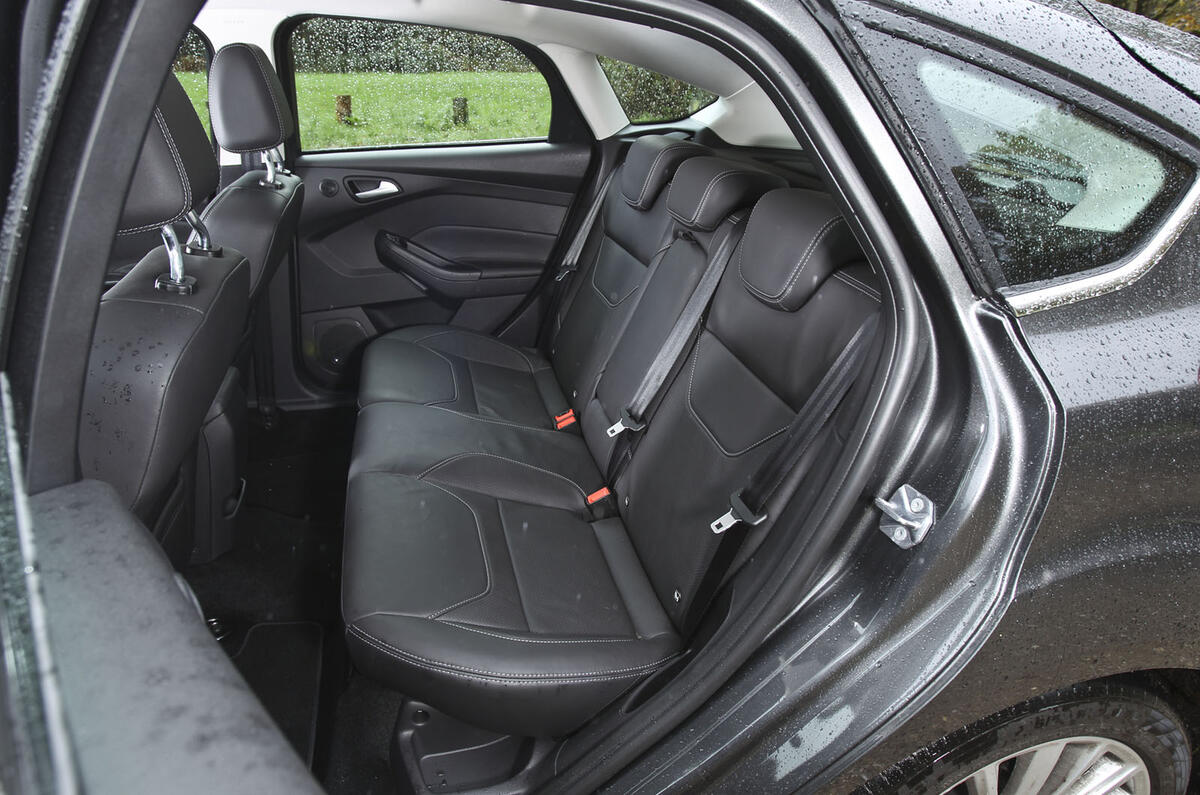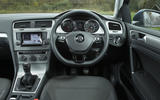‘Too close to call’ is a phrase that I’ll keep in the first sentence of this comparison test rather than use as a cop-out verdict at the end.
Splitting these two – reigning everyman hatchback champion the Volkswagen Golf Mk7 and the newly revamped Ford Focus Mk3 – is going to be tricky, such is their respective excellence. But here goes.
It’s the arrival of the latest Focus on these shores that brings this test together. When we had the chance exactly two years ago to drive an early left-hand-drive version of the latest Golf and put it up against its rivals, the VW saw off all comers, including the Focus – just – and went straight to the top of the class.
So with the opportunity to have an early go in a left-hand-drive Focus this time around, we want to find out if the deep-running changes allow the Ford to usurp the Golf as class leader.
No other rivals are needed here. Although there’s real strength and depth in the class, with the likes of the Audi A3, Mazda 3 and a revised version of the Volvo V40, to name just three, none would trouble the top two here.
What’s new with the Focus, then? You’ll have already spotted the obvious visual differences, chiefly its exterior reskin. That ‘Aston Martin grille for the people’ finds its way on to the Focus as part of a new front end, and there are detail exterior changes elsewhere.
But visually, the most significant changes come inside, where the switchgear is significantly pared back. The fussy interior was always a big weak point for this generation of the Focus, and we’ll come back to whether or not this rationalisation of the controls, done in conjunction with a leap in quality and extra cubbyholes, works in practice.
Chassis tweaks also feature on the Focus. An overhaul of the suspension system is said to reduce chassis flex and in turn allow the steering to be tuned to reduce the amount of effort needed while maintaining the precision. Which all sounds okay in theory, so long as the changes do indeed maintain and even enhance the Focus’s position as the driver’s car of choice in the class.
Under the bonnet, there’s the usual array of fleet-friendly diesels, now downsized from 1.6 to 1.5 litres in various outputs, plus a range-topping 2.0-litre version.
However, it’s the petrol versions that still intrigue most private buyers, and there’s a new 1.5-litre EcoBoost in place of the previous 1.6, plus that firm favourite, the three-cylinder, 1.0-litre EcoBoost, in various flavours, including the 123bhp version fitted to our test car. Our example is a plush and extremely well equipped £22,295 Titanium X version, with almost another £3000 in options on top, pushing it into premium money at £25,775 all in.
Read the 2014 Ford Focus first drive
The Golf here is a 120bhp 1.4 TSI petrol-powered mid-range Match model. You won’t be wanting for much equipment, our £21,700 test car (£20,335 base price plus £1365 worth of options) coming with the likes of touchscreen infotainment and adaptive cruise control.
On the spec sheet, this Golf gives away 3bhp to the Focus but has identical peak torque of 148lb ft (the Ford’s maximum figure achieved on overboost). The Focus, on paper, has an economy advantage, though. Its combined figure of 60.1mpg eclipses the Golf’s 53.3mpg, and its CO2 emissions of 108g/km also comfortably beat the Golf’s 123g/km.
I jump in the Golf first, to refamiliarise myself with the class’s benchmark. To get the subjective stuff out the way first, I think that it’s still the classiest-looking car in its sector.
The more Mk7 Golfs that I see on the road, the more I like it. I just can’t see the lines of this generation of Golf aging any time soon. Compare that with the Focus. The original Mk3 design was quite faddish and soon dated. It’s much improved now but still lacks that timeless quality.
The Golf is a car into which you can quickly relax. Like the exterior, the interior oozes timeless class and sophistication and is constructed from materials of a high perceived quality. The controls are laid out clearly and nicely weighted, and a comfortable driving position with good visibility is easily found.
Time hasn’t harmed this Golf’s visual appeal inside and out, then, and as it’s only two years old, it’s no surprise that the Golf remains a very fine car indeed to drive. It simply glides everywhere in a smooth and quiet fashion; the ride quality is unruffled by the worst that an early winter B-road can throw at it and it steers with a good level of feedback and precision, even if it’s a little light. Body control is also excellent. VW has tuned this Golf to excel at comfort, refinement, stability and predictability.
That might read as ‘unexciting’ to some, but the Golf is able to lose its straight, sensible face for a moment. That fine body control also endows the Golf with a sense of poise and nimbleneess, thanks in part to the relatively light kerb weight of 1225kg. It’s no GTI, but it grips well and urges can be satisfied.
The 1.4 TSI engine helps to that end. The old cliché that it feels quicker than its official 0-62mph time (9.3sec) suggests can be wheeled out here. It’s far from express pace, but it has a good spread of torque when you need extra shove and is a smooth, calm companion in its default running mode. Much like the rest of the car, then.
Read the full Volkswagen Golf review
The high bar that the Golf set two years ago has not got any lower, in other words, so does this Focus climb over it? Although I’ve got reservations about how well the Focus will age, there’s no doubt that its new look brings it closer to the Golf in terms of visual sophistication, perhaps overcoming in part that subconscious badge snobbiness.
The new interior is a huge improvement, too. The design of the switchgear is much simpler, with buttons easier to find and some functions ported over to the touchscreen that runs Ford’s new Sync infotainment system, which is a doddle to use. The perceived quality is also greatly improved, with more soft-touch materials and some handsome brightwork.
The VW still has the edge, though. As improved as the Focus’s interior is, it’s clear that Ford has tried to fix something that was fundamentally flawed, rather than getting it right in the first place. And the Golf’s perceived quality is still a level above.
On the move, though, the Focus claws back most of the margin lost to the Golf on static appeal. Much of the Ford’s initial driving pleasure comes from the sound of that three-cylinder engine, which oozes enthusiasm and urgency and encourages you to work it hard.
Mostly, doing so is optional and a delight, but there are times when you have to because, unlike in the Ford Fiesta, this engine in the Focus can occasionally feel like it’s the big turbo pulling you along in a bigger, heavier car.
This also partly explains why the Focus returned indicated economy in the low 40s on this test, compared with the mid-40s of the Golf, whose four-cylinder engine never has to work as hard as the zesty Focus’s.
The Ford’s greater enthusiast appeal extends to the way that it rides and handles. It steers with a touch more feel and precision and is more engaging than the Golf. Its ride is firmer than the Golf’s but no less comfortable for it, the benefit being slightly superior body control.
It has keener turn-in, helped in part by that lightweight three-pot engine over the driven wheels, and it is agile and responsive enough for some mid-corner adjustability.
In truth, though, every point that one of these cars scores over the other is marginal, and much will come down to personal preference. Which means that it’s time to get off the fence, dust off that tape measure and gauge the width of the cigaratte paper that splits this pair.
The verdict
The Golf and its superior breadth of ability nudges it. The Focus is closer to it than ever and in certain circumstances – particularly when you want to take the long way home – better to drive. But the Golf is close enough to its rival in the areas where the Focus excels and that bit further ahead in the others, such as refinement and interior quality. Whichever you buy, though, you won’t be disappointed.
Read our full review on the Ford Focus
Volkswagen Golf 1.4 TSI 122 Match
Price £20,335; 0-62mph 9.3 seconds; Top speed 126mph; Economy 53.3mpg; C02 123g/km; Kerbweight 1225kg; Engine 4 cylinders, 1395cc, turbocharged, petrol; Power 120bhp at 5000rpm; Torque 148lb ft at 1800-4000rpm; Gearbox Six-speed manual
Ford Focus 1.0T EcoBoost Titanium X
Price £22,295; 0-62mph 11.0 seconds; Top speed 120mph; Economy 60.1mpg; C02 108g/km; Kerbweight 1270kg; Engine 3 cylinders, 999cc, turbocharged, petrol; Power 123bhp at 6000rpm; Torque 125lb ft at 1800rpm; Gearbox Six-speed manual
Get the latest car news, reviews and galleries from Autocar direct to your inbox every week. Enter your email address below:















































Join the debate
Add your comment
Poor show
Surprised its not been
All this winging about rear beam suspension. The French can make it work.
The Germans can't though
dukebox9reg wrote:Surprised
I'm with you on the Leon much more honest proposition. I would like to see tests between entry level versions (both in equipment and engine) of cars in this sector see if it affects the outcome of which is the best car in the class. As others have said I'm a bit sick of manufacturers only providing expensive well equipped versions, so we can't tell what the affordable versions or even what the majority of customers will buy are like.
Styling?
I've had a VW before and I know from experience, they aint all that, especially after a few years that supposed quality feel interior doesn't seem so special, but continues to be dull. As a used car buyer I'd probably pick the Focus as it'll be cheaper to buy and no less reliable.
"Timeless Looks" simply means
All the elements work together without drawing attention to themselves (Ferrari is one of the worst in accentuating design elements at the expense of overall coherence)
abkq wrote:"Timeless Looks"
Yes I agree with you about Ferrari, personally I never liked the look of Golf 4 either, in fact the only Golf I do like the look of is the first one. The Focus isn't much better though I'd have to admit, the Mk1 is still one of my favourites (especially as a former owner of one) design wise and the way it drove, but everything since then has been too conservatively styled and continuously less Focus like to drive.